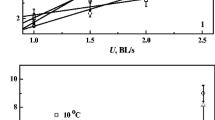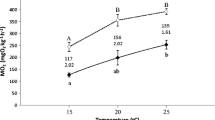Abstract
Adriatic sturgeon (Acipenser naccarii) were maintained on a commercial diet enriched either in long chain polyunsaturated fatty acids of the ω3 series (ω3 LCPUFA) or in saturated fatty acids (SFA). The effects of dietary fatty acid composition on spontaneous locomotor activity in normoxia and hypoxia (O2 tension = 10.5 ± 0.8 kPa), and on oxygen consumption (MO 2) in normoxia, in hypoxia (O2 tension = 6.6 ± 0.8 kPa) and during recovery were then investigated. The effects of adding supplementary vitamin E to the fat-enriched diets were also studied.
Dietary fatty acid composition had effects on spontaneous locomotor activity and MO 2 in normoxia. Activity levels were higher in all sturgeon fed extra dietary fats (without vitamin E), when compared with control animals, but fish fed ω3 LCPUFA had a significantly lower MO 2 than those fed SFA, with intermediate MO 2 in controls. In hypoxia, sturgeon ω3 LCPUFA did not alter activity or MO 2 whereas those fed SFA reduced both and controls reduced MO 2. During recovery, both animals fed SFA and controls had a higher MO 2 than sturgeon fed ω3 LCPUFA. The data indicate that fish fed ω3 LCPUFA are more tolerant of hypoxia than controls or those fed SFA, as they did not reduce either activity or MO 2, and consumed less O2 during recovery.
Vitamin E supplements modified the effects elicited by dietary fats. All sturgeon fed vitamin E had low activity levels in normoxia and hypoxia. Sturgeon fed vitamin E with ω3 LCPUFA had a higher MO 2 in normoxia than those fed ω3 LCPUFA alone; reduced MO 2 in hypoxia, and during recovery increased MO 2 to a rate higher than that of animals fed ω3 LCPUFA alone. In normoxia, sturgeon fed vitamin E with SFA had a similar MO 2 to those fed SFA alone but did not change MO 2 in hypoxia or during recovery. Thus, the effects of vitamin E were dependent on fat composition of the diet. Vitamin E with ω3 LCPUFA removed the beneficial effects on MO 2 and responses to hypoxia obtained with ω3 LCPUFA alone, but vitamin E with SFA allowed sturgeon to maintain aerobic metabolism in hypoxia, a more effective response than that observed in fish fed SFA alone.
Similar content being viewed by others
References cited
Agradi, E., Abrami, G., Serrini, G., McKenzie, D., Bolis, C. and Bronzi, P. 1993. The role of n-3 fatty acid and vitamin E supplements in growth of sturgeon (Acipenser naccarii). Comp. Biochem. Physiol. 105A: 187–195.
Bell, M.V., Henderson, R.J. and Sargent, J.R. 1986. The role of polyunsaturated fatty acids in fish. Comp. Biochem. Physiol. 83B: 711–719.
Budowski, P. and Sklan, D. 1989. Vitamins E and A. In The Role of Fats in Human Nutrition. pp. 363–406 Edited by A.J. Vergroesen and M. Crawford Academic Press, London.
Burggren, W.W. and Randall, D.J. 1978. Oxygen uptake and transport during hypoxic exposure in the sturgeon (Acipenser transmontanus). Respir. Physiol. 34: 171–183.
Carlson, S.E. and Salem, N. Jr. 1991. Essentiality of ω3 fatty acids in growth and development of infants. In Health Effects of ω3 Polyunsaturated Fatty Acids in Seafoods. pp. 74–88 Edited by A.P. Simopoulos, R.R. Kifer, R.E. Martin, and S.M. Barlow. Karger, Basel.
Cowey, C.B. 1986. The role of nutritional factors in the prevention of peroxidative damage to tissues. Fish Physiol. Biochem. 2: 171–178.
Cowey, C. B. and Sargent, J. R. 1979. Nutrition. In Fish Physiology. Vol. 8, pp. 1–69. Edited by W.S. Hoar and D.J. Randall. Academic Press, New York.
Dehmer, G.J., Popma, J.J., van den Berg, E.K., Eichhorn, E.J., Prewitt, J.B., Campbell, W.B., Jennings, L., Willerson, J.T. and Schmitz, J.M. 1988. Reduction in the rate of early restenosis after coronary angioplasty by a diet supplemented with ω3 fatty acids. New. Eng. J. Med. 319: 733–740.
Diplock, A.T. 1991. Antioxidant nutrients and disease prevention: an overview. Am. J. Clin. Nutr. 53: 189S–193S.
Downey, J.M. 1990. Free radicals and their involvement during long-term myocardial ischemia and reperfusion. Ann. Rev. Physiol. 52: 487–504.
Duthie, G.G., Arthur, J.R., Nicol, F. and Walker, M. 1989. Increased indices of lipid peroxidation in stress-susceptible pigs and effects of vitamin E. Res. Vet. Sci. 46: 226–230.
Fitzgerald, G.A. 1993. Omega-3 fatty acids and vascular function. Omega-3 News. 9: 1–3.
Henderson, R.J. and Tocher, D.R. 1987. The lipid composition and biochemistry of freshwater fish. Prog. Lipid Res. 26: 281–347.
Hornstra, G. 1989. The significance of fish and fish-oil enriched food for prevention and therapy of ischaemic cardiovascular disease. In The Role of Fats in Human Nutrition. pp. 151–236. Edited by A.J. Vergroesen and M. Crawford. Academic Press, London.
Lands, W.E.M. 1991. Biosynthesis of prostaglandins. Ann. Rev. Nutr. 11: 41–60.
Leaf, A. and Weber, P.C. 1988. Cardiovascular effects of ω3 fatty acids. New Eng. J. Med. 318: 549–559.
Meydani, S.N., Shapiro, A.C., Meydani, M. and Blumberg, J.B. 1992. Lung eicosanoid synthesis is affected by age, dietary fat and vitamin E. J. Nutr. 122: 1627–1633.
Miller, S.A. 1982. Nutrition & Behavior. Franklin Institute Press, Philadelphia.
Murray, M.J., Svingen, B.A., Yaksh, T.L. and Holman, R.T. 1993. Effects of endotoxin on pigs prefed ω3 vs ω6 fatty acid-enriched diets. Am. J. Physiol. 265: E920–E927.
Neuringer, M., Anderson, G.J. and Connor, W.E. 1988. The essentiality of ω3 fatty acids for the development and function of the retina and brain. Ann. Rev. Nutr. 8: 517–539.
Nilsson, G.E., Rosen, P. and Johansson, D. 1993. Anoxic depression of spontaneous locomotor activity in crucian carp quantified by a computerized imaging technique. J. Exp. Biol. 108: 153–162.
Nonnotte, G., Maxime, V., Truchot, J.P., Williot, P. and Peyraud, C. 1993. Respiratory responses to progressive hypoxia in the sturgeon, Acipenser baeri. Respir. Physiol. 91: 71–82.
Packer, L. 1991. Protective role of vitamin E in biological systems. Am. J. Clin. Nutr. 53: 51050–51055.
Randall, D.J., McKenzie, D.J., Abrami, G., Bondiolotti, G.P., Natiello, F., Bronzi, P., Bolis, L. and Agradi, E. 1992. Effects of diet on responses to hypoxia in sturgeon (Acipenser naccarii). J. Exp. Biol. 170: 113–125.
Schurmann, H. and Steffensen, J.F. 1994. Spontaneous swimming activity of Atlantic cod Gadus morhua L., exposed to graded hypoxia at three temperatures. J. Exp. Biol. (In press).
Watanabe, T. 1982. Lipid nutrition in fish. Comp. Biochem. Physiol. 73B: 3–15.
Xu, R., Hung, S.S.O. and German, J.B. 1993. White sturgeon tissue fatty acid compositions are affected by dietary lipids. J. Nutr. 123: 1685–1692.
Author information
Authors and Affiliations
Rights and permissions
About this article
Cite this article
McKenzie, D.J., Piraccini, G., Steffensen, J.F. et al. Effects of diet on spontaneous locomotor activity and oxygen consumption in Adriatic sturgeon (Acipenser naccarii). Fish Physiol Biochem 14, 341–355 (1995). https://doi.org/10.1007/BF00003373
Accepted:
Issue Date:
DOI: https://doi.org/10.1007/BF00003373




